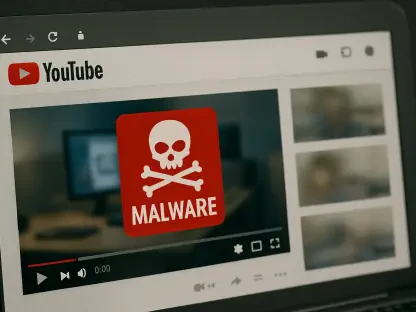Overview of a Persistent Cybersecurity Challenge
Imagine a corporate network, bustling with activity, where a single overlooked setting could allow an attacker to silently harvest login credentials without triggering any alarms, posing a severe risk to organizational security. This scenario is not a distant threat but a present reality for many organizations still reliant on outdated Windows communication protocols. A recent cybersecurity study has underscored that these legacy systems, designed for a different era, continue to expose networks to significant risks of credential theft, even without exploiting software flaws.
The persistence of such vulnerabilities highlights a broader industry challenge: balancing compatibility with security in environments where older technologies remain in use. As networks grow more complex and interconnected, the potential for exploitation through these protocols becomes a critical concern for IT teams and security professionals. This report delves into the nature of these risks, their impact, and the strategies needed to safeguard organizational assets.
Understanding the Threat of Legacy Windows Protocols
Legacy Windows protocols such as Link-Local Multicast Name Resolution (LLMNR) and NetBIOS Name Service (NBT-NS) were originally developed to assist systems in locating other devices on a network when DNS lookups fail. These mechanisms provided a fallback for name resolution in environments where centralized DNS infrastructure was not fully reliable or available. Despite advancements in network technology, many organizations continue to rely on these protocols due to compatibility needs with older systems or applications.
Their ongoing use in modern networks, however, introduces substantial security risks. Both LLMNR and NBT-NS operate on a trust-by-default basis, meaning they accept responses from any device on the local network without verification. This design flaw creates an open door for attackers to intercept communications and pose as legitimate systems, capturing sensitive authentication data in the process.
The significance of this threat cannot be overstated, as these protocols are often enabled by default on Windows systems, even in newer versions. Organizations unaware of their presence or unable to disable them due to operational constraints face a heightened risk of unauthorized access. This vulnerability underscores the urgent need for awareness and action to address an often-overlooked aspect of network security.
The Mechanics of Credential Theft via Legacy Protocols
How Attackers Exploit LLMNR and NBT-NS
Attackers exploit LLMNR and NBT-NS by leveraging their inherent trust mechanisms with tools like Responder, which can intercept broadcast queries on a local network. When a system attempts to resolve a name and fails to get a DNS response, it sends out a multicast request via these protocols. An attacker on the same network segment can reply to this request, tricking the victim system into sending authentication data, including usernames and encrypted password hashes.
This method of attack does not require exploiting software bugs or flaws but instead capitalizes on default Windows behavior. The simplicity of this approach means that any malicious actor with basic network access can execute it without needing advanced technical skills. Such ease of exploitation makes these protocols a favored target for credential harvesting campaigns.
The captured data often includes NTLM hashes, which, while encrypted, can be subjected to offline cracking attempts using powerful computing resources. This process allows attackers to potentially recover plaintext passwords or reuse the hashes in other attacks, amplifying the threat posed by a single intercepted broadcast.
Impact of Stolen Credentials on Organizations
Once credentials are stolen, the consequences for an organization can be severe and far-reaching. Attackers may use the captured data for offline cracking to uncover passwords or employ relay attacks to authenticate directly to sensitive systems such as corporate databases or file servers. In some instances, credentials may even be obtained in plaintext, granting immediate access to critical resources.
Beyond individual system compromise, stolen credentials enable lateral movement across a network, allowing attackers to access additional systems and escalate privileges. By targeting high-value accounts like those of administrators or service users, malicious actors can gain broader control over the environment, potentially affecting multiple departments or business units.
The ripple effects of such breaches include widespread data exposure, unauthorized modifications to systems, and disruption of essential services. Large organizations, with their complex and interconnected networks, face amplified challenges in containing and recovering from these incidents, often resulting in significant operational downtime and financial loss.
Challenges in Securing Networks Against Protocol Exploits
Securing networks against exploits targeting legacy protocols presents multiple hurdles for organizations. A primary challenge lies in the lack of awareness among IT teams about the risks associated with LLMNR and NBT-NS. Many systems retain these protocols as default settings, and without deliberate efforts to identify their presence, vulnerabilities may go unnoticed until an incident occurs.
Another difficulty stems from the tension between maintaining compatibility and enhancing security. Environments that still depend on older Windows systems or applications often cannot disable these protocols without risking operational disruptions. This dependency creates a dilemma for decision-makers who must weigh the potential impact on business continuity against the need to protect sensitive data.
Additionally, even when risks are recognized, implementing mitigations can be complex in large or heterogeneous networks. Ensuring consistent configuration changes across diverse systems and monitoring for compliance requires significant resources and expertise, further complicating efforts to eliminate these vulnerabilities.
Recommended Strategies to Mitigate Risks
To reduce exposure to credential theft through legacy protocols, organizations should prioritize disabling LLMNR and NBT-NS via Group Policy settings wherever possible. This step prevents systems from relying on these outdated mechanisms for name resolution, significantly lowering the attack surface. Additionally, blocking UDP port 5355 can halt multicast queries associated with LLMNR, adding another layer of protection.
Enforcing secure authentication methods, such as Kerberos, and reducing reliance on NTLM authentication are also critical measures. Coupled with SMB signing, these practices help ensure that even if data is intercepted, it cannot be easily exploited. Maintaining accurate DNS configurations is equally important to prevent systems from falling back to vulnerable protocols when lookups fail.
Beyond configuration changes, continuous monitoring of network traffic for unusual activity related to these protocols is essential. Security teams should deploy tools to detect potential exploitation attempts, such as unexpected broadcast responses, and respond swiftly to mitigate threats. Combining these technical defenses with staff training on secure practices can further strengthen an organization’s resilience against credential theft.
Future Outlook: Moving Beyond Legacy Protocols
The long-term solution to risks posed by legacy Windows protocols lies in transitioning to modern, secure alternatives that prioritize authentication and verification. As cybersecurity practices evolve, organizations must adopt frameworks and technologies that eliminate reliance on outdated systems, ensuring that compatibility no longer comes at the expense of protection. This shift requires a cultural change within IT departments to embrace forward-looking strategies over temporary fixes.
Emerging tools, such as advanced endpoint detection and response platforms, offer enhanced visibility into network activities, helping to identify and block malicious behavior in real time. Additionally, adopting zero-trust architectures can minimize the impact of stolen credentials by requiring continuous verification, regardless of a user’s location or device. These innovations represent a proactive approach to securing environments against evolving threats.
Investment in regular security assessments and updates to infrastructure will also play a vital role in preventing credential theft. By staying ahead of potential vulnerabilities through periodic reviews and adopting best practices, organizations can build robust defenses that adapt to changing attack vectors. The path forward demands a commitment to modernization and vigilance to safeguard critical assets.
Final Reflections and Path Ahead
Looking back, the exploration of legacy Windows protocols revealed a persistent and preventable threat to network security through credential theft. The ease with which attackers exploited default behaviors underscored a gap in many organizational defenses. Discussions around the impact of stolen credentials painted a stark picture of potential data breaches and operational disruptions that followed unchecked vulnerabilities.
Reflecting on these insights, actionable steps emerged as a priority for mitigating risks. Organizations were encouraged to disable outdated protocols, enforce secure authentication, and invest in monitoring tools to detect exploitation attempts. These measures, though resource-intensive, stood as necessary actions to protect sensitive environments from unauthorized access.
Moving ahead, a focus on strategic planning offered hope for sustained security. Transitioning to modern protocols and embracing zero-trust models provided a blueprint for resilience against future threats. By committing to these initiatives, businesses positioned themselves to navigate the challenges of a legacy environment with confidence and foresight.









